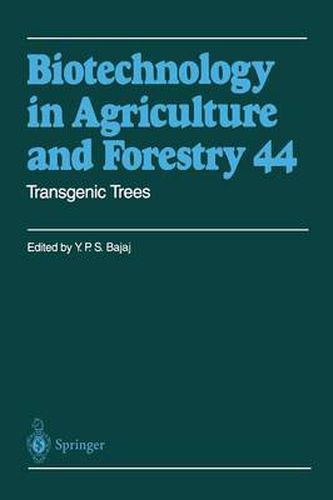Readings Newsletter
Become a Readings Member to make your shopping experience even easier.
Sign in or sign up for free!
You’re not far away from qualifying for FREE standard shipping within Australia
You’ve qualified for FREE standard shipping within Australia
The cart is loading…






This title is printed to order. This book may have been self-published. If so, we cannot guarantee the quality of the content. In the main most books will have gone through the editing process however some may not. We therefore suggest that you be aware of this before ordering this book. If in doubt check either the author or publisher’s details as we are unable to accept any returns unless they are faulty. Please contact us if you have any questions.
Over the last decade there has been tremendous progress in the genetic transformation of plants, which has now become an established tool for the insertion of specific genes. Work has been conducted on more than 200 plant species of trees, cereals, legumes and oilseed crops, fruits and vegetables, medicinal, aromatic and ornamental plants. Transgenic plants have been field-tested in a number of countries, and some release_d to the farmers, and patented. Taking the above-mentioned points into consideration, it appeared nec- essary to review the literature and state of the art on genetic transformation of plants. Thus 120 chapters contributed by experts from 30 countries (USA, Russia, Canada, France, Germany, England, The Netherlands, Belgium, Switzerland, Italy, Spain, Bulgaria, Yugoslavia, Denmark, Poland, Finland, Aus- tralia, New Zealand, South Africa, China, Japan, Korea, Singapore, Indonesia, India, Israel, Mexico, Cuba, etc. ) are compiled in a series composed of the fol- lowing five books: 1. Transgenic Trees comprises 22 chapters on forest, fruit, and ornamental species such as Allocasuarina verticillata, Casuarina glauca, Cerasus vul- garis, Citrus spp. , Coffea species, Diospyros kaki, Eucalyptus spp. , Fagara zanthoxyloides, Larix spp. , Lawsonia inermis, Malus x domestica, Picea mariana, Pinus palustris, Pinus radiata, Poncirus trifoliata, Populus spp. , Prunus species Rhododendron, Solanum mauritianum, Robinia pseudoa- cacia, Taxus spp. , and Verticordia grandis. 2.
$9.00 standard shipping within Australia
FREE standard shipping within Australia for orders over $100.00
Express & International shipping calculated at checkout
Stock availability can be subject to change without notice. We recommend calling the shop or contacting our online team to check availability of low stock items. Please see our Shopping Online page for more details.
This title is printed to order. This book may have been self-published. If so, we cannot guarantee the quality of the content. In the main most books will have gone through the editing process however some may not. We therefore suggest that you be aware of this before ordering this book. If in doubt check either the author or publisher’s details as we are unable to accept any returns unless they are faulty. Please contact us if you have any questions.
Over the last decade there has been tremendous progress in the genetic transformation of plants, which has now become an established tool for the insertion of specific genes. Work has been conducted on more than 200 plant species of trees, cereals, legumes and oilseed crops, fruits and vegetables, medicinal, aromatic and ornamental plants. Transgenic plants have been field-tested in a number of countries, and some release_d to the farmers, and patented. Taking the above-mentioned points into consideration, it appeared nec- essary to review the literature and state of the art on genetic transformation of plants. Thus 120 chapters contributed by experts from 30 countries (USA, Russia, Canada, France, Germany, England, The Netherlands, Belgium, Switzerland, Italy, Spain, Bulgaria, Yugoslavia, Denmark, Poland, Finland, Aus- tralia, New Zealand, South Africa, China, Japan, Korea, Singapore, Indonesia, India, Israel, Mexico, Cuba, etc. ) are compiled in a series composed of the fol- lowing five books: 1. Transgenic Trees comprises 22 chapters on forest, fruit, and ornamental species such as Allocasuarina verticillata, Casuarina glauca, Cerasus vul- garis, Citrus spp. , Coffea species, Diospyros kaki, Eucalyptus spp. , Fagara zanthoxyloides, Larix spp. , Lawsonia inermis, Malus x domestica, Picea mariana, Pinus palustris, Pinus radiata, Poncirus trifoliata, Populus spp. , Prunus species Rhododendron, Solanum mauritianum, Robinia pseudoa- cacia, Taxus spp. , and Verticordia grandis. 2.